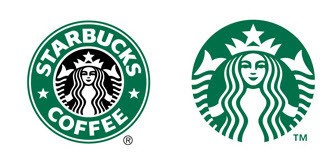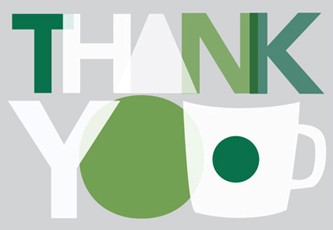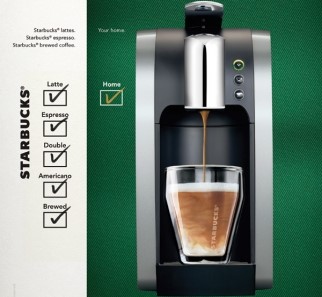Starbucks - A Brand Analysis

|
Author: Mark Miceli-Farrugia |

|
Dated: 2013-07-10 |

|
Uploaded: 2019-09-02 |

|
Last Edited: 6 years ago |
STARBUCKS - A BRAND ANALYSIS PAPER
Mark Miceli-Farrugia
 Old Logo New Logo
Old Logo New Logo
(without Coffee Mention)
1.0 COMPANY OVERVIEW
1.1 Company History
Howard Schultz (Starbuck’s current chairman, president and CEO) was drawn to Starbucks’ first and only store in Seattle by the cup of Sumatra coffee he had enjoyed there in 1981.
He joined the company a year later. A year later still – in 1983 - he travelled to Italy where he developed a romantic vision. He would re-create the Italian espresso bar experience in America. He would evoke an ambiance which would serve as a place for conversation and sense of community: A Third Place between Work and Home.
Shultz left Starbucks for a short time only to return to purchase the company with the help of local investors in 1987. His innovative mission statement was: “To inspire and nurture the human spirit – “one person, one cup, and one neighborhood at a time.” (1)
1.2 Company Performance
Today Starbucks have more than 17,000 stores and 149,000 employees in 55 countries making it the world’s premier roaster and retailer of specialty coffee. (2)Worldwide, the company’s net earnings for 2011 were $2,075 millions, 19.4% of total net revenues, an increase of 19.9% over the previous year. (3)In the Starbucks’ Accounts for the Americas (of which the US constituted a large part), the company’s net earnings for 2011 were $1,842 millions, 20.3% of total net revenues, an increase of 14.7% over the previous year. (4)
Starbucks is listed as number 88 in Interbrand’s Best Global Brands in 2012. (5)
1.3 Product Offerings
- The product offerings falling under the Starbucks umbrella brand originally consisted of a variety of Regular and Decaf Whole Bean Coffees and an assortment of Tazo Teas.
- Today Starbucks also sells in its own stores and in retail outlets premium bagged ground coffee for at-home consumption. In January 2012, Starbucks announced that it would be introducing Starbucks Blonde Roast, a super-premium, great-tasting, quality lighter roast coffee. This completed the range of Blonde, Medium, and Dark coffees available in whole bean, roast, ground, Ready Brew and Portion Packs. (6)
- In February 2012, Starbucks announced it would be offering wine and beer to their customers “as a way to unwind.”
- The franchise said it would also sell “premium food offerings” as part of the expansion to cater for customers into the evening. The new premium food would include savory snacks, small plates and hot flatbreads, while the wine and beer list will be “hand-selected to reflect local customer tastes and preferences, and will be refined over time”.
- The old ubiquitous logo – a deep green ring emblazoned with Starbucks Coffee, encircling a black-and-white siren – was replaced by a circular image of the green and white siren, with no mention of coffee or the company – see contrasting before-and-after logos upfront. (7)
- In October 2012, Starbucks began selling online its espresso maker Verismo serving single-cup coffee pods. It also introduced a Refreshers energy drinks made from green coffee extract. Starbucks customers could start paying for their in-store purchases with their mobile phones via the Square Wallet system. (8)
2.0 SITUATION ANALYSIS - Porter’s Five Key External Forces
We shall be studying Starbucks USA on the basis of Michael Porter’s Five Key External Forces. (9)
2.1 Porter’s First Force: Industry Rivalry
Owing to its success, Starbucks US today competes with a variety of companies of varying sizes: national chains; specialty coffee shops; and coffee-pod marketers. [Worldwide, it may also be competing with a resurgence of Italian ventures seeking to capitalize on Italy’s coffee-making heritage.]
2.1. National Chains of Fast Food Companies
There are two main national chains: Dunkin Donuts and McDonald’s McCafe’ are the most significant.
2.1.1 Dunkin Donuts
Dunkin Donuts claims to be “the world’s largest coffee and baked goods chain.” It operates around 6,600 franchises around the US, and an additional 2,580 throughout the world. In 2011, Dunkin Donuts recorded net revenues of $ 101 million. The company provides a variety of coffee beverages similar to Starbucks – espresso, cappuccino, and latte. Like Starbucks, Dunkin Donuts also serve their coffees in an assortment of flavors including vanilla.
When Starbucks temporarily shut down 7,100 of their stores in 2007 to retrain their baristas, Dunkin Donuts took the opportunity of extending their hours of operation and offering specials. (10)
2.1.2 McDonald’s
With 13,900 restaurants in the US alone and an additional 17,100 franchises around the world, McDonald’s achieved net revenues of $8,530 million in 2011, McDonald’s has the world’s largest restaurant chain. The key to its success has been consistent quality standards, quick service, and low prices (11)
Recent developments have brought McDonald’s and Starbucks into direct competition:
- McDonald’s marketing of a variety of coffee beverages under the name of McCafe’;
- McDonald’s upgrading of its general ambiance;
- McDonald’s introduction of competitive bar-counters and baristas; and
- Starbucks’ entry into the drive-through snack-food trade. (12)
2.2 Small-Scale Specialty Coffee Shops
There are also a number of small-scale specialty coffee shops mostly concentrated in different US regions: the most serious threat is posed by Caribou Coffee. Caribou is similar to Starbucks in their its attempt to create “a third place between work and home.” However, whereas Starbucks strives to create an upscale European atmosphere, Caribou tries to infuse a more American, rustic Alaskan lodge feel to its coffee houses.
2.3 Consumer Marketers of Coffee Pods for At-Home Consumption
More recently, Starbucks’ has come into direct confrontation with mass-marketers Nestle’ Nespresso and Kraft’s Tassimo when it launched its Verismo espresso maker using single-cup, coffee pods,.
2.2 Porter’s Second Force: Threat of New Entrants
The larger companies have been able to economize on their scale of operations in the coffee beverage sector, thus posing cost disadvantages and barriers to entry to new prospects wishing to enter the sector.
Besides, existing companies have already occupied most of the favorable store locations within the larger metropolitan areas. (13)
2.3 Porter’s Third Force – Threat of Substitute Products
The main substitute products which might pose a threat to the specialty coffee industry are the caffeinated soft drinks (Pepsi & Coke). However, studies show that coffee has gradually gained preference over carbonated soft drinks as an accompaniment to meals or snacks. This may have been prompted by evidence showing that coffee is a relatively healthy alternative to carbonated soft drinks. (14)
​​​​​​​2.4 Porter's Fourth Force: Supplier Bargaining Power
With the extensive growth in the specialty coffee industry, supplier bargaining power has changed in numerous ways.
Farmers selling to Starbucks are today strengthened in their bargaining power by the TransFair USA initiative. This ensures that coffee farmers are compensated fairly for their crops. Besides, increased competition among buyers further increases farmers’ bargaining power.
Suppliers’ forward integration into setting up coffee shops is improbable.
​​​​​​​2.5 Porter’s Fifth Force: Buyer Bargaining Power
The primary buyers in the specialty coffee industry are individual buyers who do not engage in concerted behavior. Although some buyers do purchase in large volumes - multinational customers serving Starbucks in their offices, their loss would not be detrimental to a large sales company like Starbucks. (15)
Owing to the availability of information regarding market variables, buyers’ backward integration into the farming sector is not improbable. (16)
In sum, analysis on the basis of Porter’s Five Key External Forces suggests that industry rivalry in the coffee sector has produced an extremely competitive environment where differentiation is difficult and where price wars are looming.
3.0 STARBUCKS’ POSITIONING STRATEGY
3.1 Target Market
A Starbucks Customer Survey of 2002 (17) indicated that the trendy, young, urban, upper income, office workers, aged 18-49, who had constituted Starbucks early adopters (a.k.a. super-influencers) during the 1990s had been nearly fully penetrated and that additional growth should, therefore, be sought from the early majority – “adult consumers with middle incomes who have a desire to display their new-found success.”
3.2 SWOT Analysis – Table 1
|
INTERNAL - Strengths
|
INTERNAL - Weaknesses
|
|
EXTERNAL – Opportunities
|
EXTERNAL – Threats
|
3.3 Competitive Frame of Mind
The closest competitive frame of mind has been the experience evoked by the Italian espresso bar – Oldenburg’s ‘Third Place’ between Home and Work (18) – a public space that functions as a social gathering point and provides a proverbial home-away-from-home, where a person can experience camaraderie and community. Companionship is critical in societies with large numbers of separated or divorced persons.
In the ideal case, patrons believe that they are being personally enriched by their relationship to the establishment’s ‘Barista’ (a.k.a. ‘The Proprietor’) – the heart and soul of this commercial intimacy.
Starbucks is an upscale, homely, relatively tranquil, meeting place for friends or away-from–work computing place which contrasts glaringly with the noisy atmosphere associated with the traditional pub or with less personalized, family-oriented outlets like Dunkin Donuts or McDonald’s.
3.4 A Comparative Profile
Table 2: Key Coffee-House Competitors – A Comparative Profile
|
2011 |
Starbucks |
Dunkin’ Donuts |
McDonald’s McCafe |
|
|
|
|
|
|
Age Profile |
Adults |
All ages |
All ages |
|
Income |
Middle/Upper |
Lower/Middle |
Lower/Middle |
|
Patronage Hours |
All Day |
Breakfast + Snacks |
All Day |
|
Food Type |
Coffee + Quality Sandwiches, Salads +Pastries + Soft/ + Hard Beverages |
Coffee + Pastries + Sandwiches + Salads + Soft Drinks |
Soft Drinks + Burgers + Sandwiches + Salads + Coffee |
|
Ambiance – US |
Trendy + Clean |
Basic + Clean |
Basic + Clean |
|
Ambiance – Ex-US |
,, ,, ,, ,, |
,, ,, ,, ,, |
Classic Counter-Serv |
|
Cost per Outlet ( ) |
$350,000 |
$200,000 |
$250,000 + $100,000 (Class Cntr Upgrade) |
|
Number of Outlets |
|
|
|
|
12,400¹ |
6,600² |
13,900³ |
|
17,000¹ |
9,180² |
31,000³ |
|
Ann. Net Revenue |
$10,700 millions¹ |
$ 101 millions² |
$8,530 millions³ |
|
Location |
Visible Office Areas |
Accessible by Car |
Main Roads |
|
Advertising Tagline |
“Come Together” |
“America runs on Dunkin’” |
“My Me Time” |
² http://investor.dunkinbrands.com/releasedetail.cfm?ReleaseID=647486 ³http://www.aboutmcdonalds.com/content/dam/AboutMcDonalds/Investors/Investors%202012/2011%20Annual%20Report%20Final.pdf
3.5 Points of Difference
- Starbucks distinguishes itself through the effective application of relationship marketing: an adroit ‘Barista’ can establish an authentic rapport with his patrons;
- Starbucks has a more upscale, adult clientele than do Dunkin Donuts / McDonald’s;
- Starbucks’ product offerings and ambiance are also different;
- The adult patronage and the ambiance facilitates conversation and/or concentration on one’s laptop leisure-work, etc;
- Unlike Dunkin’ Donuts and McDonalds, Starbucks is the only outlet which serves alcohol;
- Although Starbucks has fewer outlets than McDonalds, it is a financially more solid organization than either of its rivals.
3.6 Points-of-Parity
- Simple, easy-to-serve, food & drinks;
- Coffee’s perishability necessitates attentive quality control;
- Centrally located outlets.
​​​​​​​3.7 Augmented Benefits
- Rational:
- Homely, warmly laid-out, and well-appointed store;
- Carefully selected, tranquil, soft music;
- Easy access to chargers for computers.
- Emotional:
- The rapport developed between patrons and Starbucks’ ‘Baristas’;
- The outlet’s upscale ambiance;
- The quality perception of the coffee, and food offerings;
- Soothing music – classical, jazz permitting conversation; meditation or concentration.
​​​​​​​3.8 Brand Personality
Starbucks’ brand personality is its ability to deliver consistently a communal and convivial ambiance and the emotional warmth of a quaint European café’. The brand’s success depends primarily upon the ability of the outlet’s ‘Barista’ to animate the establishment and inspire his patrons. He would be the devoted artisan who educates the palettes of his clientele – in the manner of a wine connoisseur. This type of personality is notably absent from most mass-marketed service operations.
​​​​​​​3.9 Brand Mantra
Friendliness, Quality, Comfort [FQC]
​​​​​​​3.10 Brand Positioning
“There is nothing like the Starbucks experience, a real indulgence, everyday.”
4.0 STARBUCKS’ MARKETING PROGRAM
Starbucks is presently operating as though it were two separate companies:
4.1 Starbucks Coffee Bar - Experiential (Service) Marketing
Starbucks’ Coffee Bar is the original concept which spawned the successful company. This is where Starbucks’ production and marketing expertise lies.
Starbucks markets its coffee bar experience primarily via the mobile media.
From its inception, Starbucks has tended to prefer publicity to the TV medium. (19) This was not just because of the high absolute cost of the TV medium. It is because the publicity medium lent itself better to the build-up of community spirit (the Customer Relationship Management) underlying Starbucks’ Third Place concept. The brand has been known to spend an estimated $95 million on both online and offline advertising. (20)
Starbucks’ adaptation of Customer Relationship Management (CRM) to the digital age has earned it the prestigious ‘Mobile Marketer of the Year’ award twice in the past three years: 2010 and 2012.
“Instead of following in the steps of competitors, the coffee giant has implemented its own mobile-first strategy that is unlike any other and features the latest technology such as QR (Quick Response) codes and augmented reality, as well as traditional channels including SMS, mobile advertising and applications.” (21)
4.2 State-of-the-art Integrated Marketing Communications
Starbucks’ is pioneering an integrated marketing communications strategy which creates an ongoing relationship between the brand and its customers:
- Starbucks helps opted-in consumers to celebrate their birthdays by mailing them an electronic postcard which is redeemable for a free drink of their choice.

Starbucks sends Cards electronically for a fast and budget-friendly delivery option.
- It uses in-store signage and email to boost SMS programs building its ‘My Starbucks Rewards’ and keeping consumers informed about its latest offers and discounts. Payments with Starbucks Cards earn consumers free drinks and refills.
- Starbucks strategically places its mobile QR codes where they are visible to consumers. When scanned, the mobile bar codes take coffee lovers to the company’s mobile-optimized site where they are able to watch a video and learn more about the company’s coffee.
- The coffee company uses QR codes to spread the word about its Verismo products, and help consumers purchase the products via their smartphones by scanning the mobile bar code.
- By downloading Starbucks Card’s mobile app, consumers can check their balance, reload their card and view transactions. Since November 2012, Starbucks has experienced more than 2 million mobile payment transactions every week.
- Last year, Starbuck engaged consumers further by introducing an augmented reality app to bring its holiday red cups to life !
- According to a Digital CoCo marketing analysis of social media sentiment in the first half of 2012, Starbucks is the “most loved” of 3,400 food and restaurant brands. One reason is its success in appealing to “super influencers” – mainly men and women in the 18-49 age group. (22)
- In the Digital CoCo survey, men were a bit more likely to rate a place for its “good food” than women did. Sterling Brands expert Debbie Millman comments that, for women, brand choices depend more on “the camaraderie as well as a sense of style.” (23)
4.3 Starbucks Verismo Coffee Machine - Functional (Product) Marketing
The sale of a coffee machine is a diversification for Starbucks. The company has been obliged to move into the promising At-Home, premium, single-serve coffee segment because of:
-
- the anticipated maturation of coffee-bar sales; and
- the predicted growth in At-Home, premium coffee sales.
This new venture, however, requires different distribution, personal selling, and mass-marketing skills – specializations with which Starbucks is unfamiliar.
Starbucks is marketing Verismo Coffee Machine essentially as a product on the strength of its functional attributes – the capacity to produce three types of coffee: brewed coffee, espresso, and espresso-based drinks. Starbucks is marketing this product primarily through the classic broadcast and print advertising media and personnel selling.
Whereas in the past, Starbucks has tended to prefer non-traditional advertising media vehicles, it was late last year obliged to organize one of its biggest marketing blitzes ever to promote the sale of Verismo, its innovative coffee machine for home use. This product is being sold not just in Starbucks stores, but also at kitchenware stores like Williams-Sonoma, Sur La Table, Bed Bath & Beyond, and Macy’s, as well as specialty retailers abroad.

Verismo Coffee Machine
Starbucks is dedicating an estimated $25 million on prime network and cable TV spots, lifestyle print ads, social media and digital marketing to promote “the only single-serve machine available at retail that’s capable of producing three types of coffee: brewed coffee, espresso, and espresso-based drinks such as lattes (Starbuck sells milk pods for lattes).” The two Verismo models retail for $199 and $399. (24)
Starbucks competitors in the coffee machine business are Nestle’s Nespresso, Kraft Foods’ Tassimo, and Keurig, the manufacturer of Starbucks’ own coffee machine.
5.0 HOW STRONG IS THE STARBUCKS BRAND?
The Starbucks’ brand is uniquely and securely positioned in the coffee-house business. The foregoing (especially Tables 1 & 2) suggest that the brand enjoys a strong personality that does not face any direct threat from any of its leading competitors.
6.0 HOW SHOULD ONE MEASURE BRAND SUCCESS?
All the literature about Starbucks stresses the capability of the organization to establish strong rapport with its customers, through its Baristas and the social media. This strong one-to-one relationship clearly affords useful, spontaneous, market-related feedback.
However, the influential nature of the Starbucks setting, and the Barista’s subjective involvement, will never guarantee the reliability and the objectivity of the answers sought by marketers, e.g.:
- Is the brand properly positioned?
- Do Baristas provide the personable service expected from customers?
- Is the current pricing strategy consonant with customers’ perceptions of value?
Such issues and others are best addressed during focus-groups sessions organized amongst Starbucks’ registered members and also potential prospects. The attached Catalyst Do-It-Yourself Brand Score Card serves as a useful template. (25)
7.0 RECOMMENDATIONS
The major concern is that, in undertaking the marketing of the Verismo coffee machine, Starbucks may be entering a field in which it has limited expertise.
In view of the Starbucks company’s financial solidity, it might have been more synergetic to tie-up efforts with a company which already possesses the essential expertise. For example, there are fitting Italian coffee-machine-manufacturers who would welcome such an opportunity to develop the American At-Home, premium, single-serve, coffee market.
​​​​​​​8.0 REFERENCES
Starbucks Heritage on the company’s website www.starbucks.com/
- Ibid.
- www.investor.starbucks.com
- Ibid.
- Interbrand’s Best Global Brands 2012
- www.foodandbeveragepeople.com/cm/news/starbucks_blonde_roast
- www.timesofmalta.com/articles/view/20120210/food-drink/Starbucks-expands-range-of-beverages.406567
- www.brandchannel.com/home/post/2012/10/05/Starbucks-Innovation-Mobile-100512.aspx
- www.freelancerconsulting.com/business-frameworks/porter-five-forces-model-external-analysis.html
- Starbucks Upgrades Espresso Machines, Janet Adamy, WSJ.com, November 26, 2007
- McDonald’s Takes on a Weakened Starbucks, Janet Adamy, WSJ.com, January 7, 2008
- Is Starbucks a Broken Brand?, Herb Greenberg, WSJ MarketWatch, January 7, 2008
- Starbucks Slows Expansion, Seeks New Customer Segment, Janet Adamy, WSJ.com, January 31, 2008
- The Starbucks Effect, Harding V.V., 2000, Boston, Harvard Business School.
- With Starbucks, Investors Need Patience, Janet Adamy, WSJ.com, February 4, 2008
- Is Starbucks a Broken Brand?, Herb Greenberg, WSJ MarketWatch, January 7, 2008
- Starbucks Consumer Survey, 2002 reported on Exhibit 8
- The Great Good Place, Ray Oldenburg, Marlowe & Company, 1997
- The Fall of Advertising & The Rise of PR, Al Ries & Laura Ries, Harper Business, 2002, p. 115
- What Top Brands Spend on Advertising, Janet Thaeler, Marketing Pilgrim, October 16, 2006
- Starbucks is 2012 Mobile Marketer of the Year, Rimma Kats, Mobile Marketer, December 31, 2012.
- Starbucks is “best loved” food brand on social media, Richard Satran, NBC Business, January 23, 2013.
- Ibid.
- Starbucks Ad Blitz Positions Triple-Duty Coffeemaker as Singular Sensation, Maureen Morrison, Advertising Age, October 08,2012
- http://www.catalystb2b.com/linkservid/D33947E6-D0D1-797F-5E384A3C09C1EC4D/showMeta/0/

Ratings